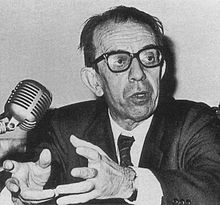Nino Lamboglia
Nino Lamboglia (born August 7, 1912 in Porto Maurizio , † January 10, 1977 in Genoa ) was an Italian archaeologist . He founded the Istituto Internazionale di Studi Liguri .
Life
Origin and early years
His father Carmelo Lamboglia from Aurigo was a teacher and musician, his mother was Carmelina Federici.
Nino Lamboglia graduated from the University of Genoa in 1933 with a thesis on Topografia dell'Ingaunia nell'antichità ( Eng .: "The topography of Ingaunia in antiquity"), in which he dealt with the archeology of the Ligurian Riviera di Ponente . In the same year he founded the Società Storico Archeologica Ingauna in Albenga and became secretary of the toponomastic (local naming) commission of Liguria . He then worked in the archives of the municipality of Albenga, where he was also director of the city library from 1934 to 1937, which he rebuilt after a period of crisis. He was also appointed extraordinary commissioner of the Museo Clarence Bicknell in Bordighera , during which time he worked with Luigi Bernabò Brea , who was also an archaeologist and a pioneer of scientific methods in archeology.
Professional background
In the following years Nino Lamboglia published several studies and participated in the archaeological research of the Riviera di Ponente. In 1942 he founded the Istituto Internazionale di Studi Liguri in Bordighera , of which he was director until his death in 1977. He also worked as an inspector in the Soprintendenza for the Liguria region in order to preserve the cultural assets of Liguria, in particular the Biblioteca Civica Aprosiana, during the Second World War . It was Nino Lamboglia who kept the texts and the valuable manuscripts of the famous library, which otherwise would probably have been lost or destroyed as a result of the war. During the Italian occupation of Menton (1940-1943) he was commissioned by civil commissioner Frediani to coordinate Italian cultural activities in collaboration with the Mentonasco poet Marcello Firpo . In the 1950s he participated in their relocation and restoration. In the post-war period he was also involved in underwater excavations and archaeological research in other Italian regions such as Sicily and Rome .
In 1974, Nino Lamboglia became the first Italian to hold a chair in Medieval Archeology at the University of Genoa.
Accidental death
Nino Lamboglia died in a tragic accident on January 10, 1977 when his car in the port of Genoa missed the access ramp to a ferry in the fog and the car crashed into the harbor basin. He and his companion Giacomo Martini drowned in the car.
Act

From his scientific work the following are of lasting importance:
- The first excavations, carried out at Villa Matutia in Sanremo in 1936 and resumed in 1960.
- The excavation campaigns in the Roman city of Albintimilium ( Ventimiglia ) (1938–1940, published in 1955), in which he was one of the first in Italy to use the stratigraphic method in the classical context. He had learned this method in collaboration with Luigi Bernabò Brea .
- Excavations in the Roman baths of Cemenelum ( Cimiez near Nice ) in June and July 1943.
- The excavation of the Roman ship of Albenga (1950) and the subsequent creation of an experimental center for underwater archeology , from which intensive underwater research of the Italian seas was undertaken.
- The investigation and attention to the small finds that arose during the excavations, in particular to the pottery, to which he made a significant contribution to the classification and identification, with the investigation of black glazed Campanian pottery and the African Red Slip Ware .
Nino Lamboglia devoted himself particularly to the research of the ancient Roman road Via Aemilia Scauri , which was built around 109 BC. Existed and the traces of which have largely been lost, their actual course is still unclear.
He excavated a pre-Roman necropolis near Chiavari , carried out excavations in Tindari in Sicily and in Rome in the Caesar forum , and also in Ampurias in Catalonia . Nino Lamboglia was also involved in the restoration of the Cathedral of Albenga.
Honors
The Museo Archeologico Navale "Lamboglia" on the Isola della Maddalena near Sardinia is named after Nino Lamboglia , where archaeological finds from Lamboglia from the vicinity of the Isola di Spargi are collected.
Web links
- Alberto Petrucciani: Lamboglia, Nino. In: Dizionario bio-bibliografico dei bibliotecari italiani del XX secolo. AIB Pubblicazioni, May 1, 2020, accessed June 26, 2020 .
- Lamboglia, Nino. In: Enciclopedie on line. Istituto della Enciclopedia Italiana, Rome. Retrieved June 27, 2020.
- Publications by Nino Lamboglia in the Opac des Servizio Bibliotecario Nazionale (SBN)
- Standard entry in the Opac of the SBN
Individual evidence
- ^ Giorgia Teso: Gli anni '40 del novecento: Luigi Bernabò Brea e Nino Lamboglia. (PDF, 58 kB) Retrieved June 26, 2020 (Italian).
- ^ A b Alberto Petrucciani: Lamboglia, Nino. In: Dizionario bio-bibliografico dei bibliotecari italiani del XX secolo. AIB Pubblicazioni, May 1, 2020, accessed June 26, 2020 .
- ^ Giuseppe Frediani: La pace separata di Ciano. Bonacci editore, Rome 1990.
- ↑ Un noto archeologo annega a Genova . In: La Stampa . January 12, 1977, p. 8 .
- ^ N. Lamboglia: Scavi nelle terme di Cemenelum. In: Rivista di Studi Liguri 11, 1945, pp. 3-30.
| personal data | |
|---|---|
| SURNAME | Lamboglia, Nino |
| BRIEF DESCRIPTION | Italian archaeologist |
| DATE OF BIRTH | August 7, 1912 |
| PLACE OF BIRTH | Porto Maurizio |
| DATE OF DEATH | January 10, 1977 |
| Place of death | Genoa |
